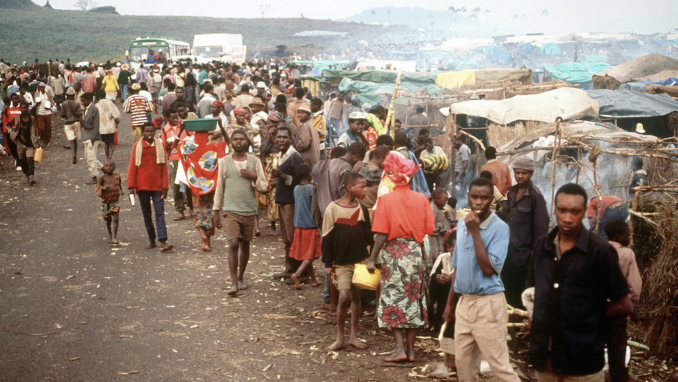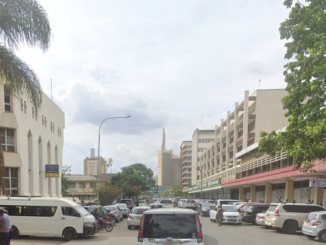
Refugee camp near Goma, Zaire (DR Congo),
SRA Andy Dunaway – Public domain
If “keep us safe” was the RPF’s public driving mantra, it was easier said than done. Having taken a generation for Uganda refugee camps to produce a rebel force capable of threatening Rwanda’s national security, this time it would take only a few years.
The status quo, in which a large proportion of Rwanda’s population squatted in 40 IDP camps necklacing the frontier, was clearly unsustainable. Yet the refugees stayed put, refusing seats on UN buses. Of those that attempted, camp administrators would gather up a sprinkling of dead bodies, which included Hutus who had attempted to board: a clear message from the génocidaires to the rest. Refugees were used as both shields and hostages.
The camps sat illegally close to the Rwandan border, and the readiness of UK’s Oxfam, Save the Children, Ireland’s Concern and Goal NGOs plus UNICEF kept providing a formative rebel-army-in training with food, water, health treatment, violating every principle of international law. But NGO officials, outnumbered and intimidated, turned a blind eye.
In October 1995, Rwanda’s RPA on the border was being attacked daily. By mid-1996, the Army for the Liberation of Rwanda (ALIR) as a Hutu force in exile dubbed itself, had created two large divisions, one focused on attacking Rwanda’s northwest, the other on its southwest.
Kagame, now with the perfect “Western geopolitical” smokescreen for Lame stream, made it clear that if the international community wouldn’t stop the border situation, the RPF would. The smokescreen being US, UK, and to a degree Kagame had already decided beforehand, the only way to neutralise the génocidaire threat involved invading Zaire, part of which meant breaking up the camps and forcing refugees back to Rwanda.
The plan (for public consumption) was the rest of the world had learnt to associate with the RPF, a movement beginning to believe its own narrative and having a military Midas touch. But if the RPF was to invade Zaire, its second cross-border operation in only six years, without alarming the African Union (AU), the “UN”, Kigali’s “Western friends – UK, US” came to the fore with the camouflage. A frontman giving local credibility, while at the same time doing exactly what he was told was needed. The ideal “candidate” was Laurent Kabila, a militant from Katanga province quietly going to seed in Tanzania, under the protective aegis of retired Julius Nyerere. Nyerere, and this time also M7, together arranged for Kabila to be taken to Kigali. Kabila’s disappointing track record included his commanding of Simba rebels fighting and losing against Mobutu forces in the early 1960s.
As he was a genuine Congolese “son of the soil” and in contrast with all other of Zaire’s opposition leaders, hadn’t been bought off by Mobutu, which ticked the “credit box”. The Western string pullers decided they weren’t looking for a rebel leader, just someone to make the whole operation look Congolese.
Despite the usual challenges for any force needing Rwandans for food, clothing, uniforms, weapons (and travel expenses), the one area Congolese could deliver was recruitment and mobilisation in Zaire. In South Kivu, in particular, local Tutsis, known as Banyamulenge were increasingly worried about the xenophobic rhetoric toward the community from Mobutu’s officials. They signed up in their thousands.
The Western government-sponsored approach gradually mutated into a covert nine-nation, pan-African project to topple the ageing Mobutu. By late 1996, the “rebels”, Rwandan minders were ready. Rwanda, now emerging as a regional superpower obtained through the force of arms, which was allowed to prevail because of the tolerance inspired by international feelings of guilt after the genocide. Paraphrasing what was said in the late 19th century about Prussia, Rwanda became an army with a state, rather than a state with an army, and it emerged as a major factor of ongoing regional instability. On 18th October the coalition published the Lemera Declaration unveiling the Alliance of Democratic Forces for Liberation of Congo-Zaire (AFDL).
The First Congo War
One week later, Rwanda’s army, commanded by James Kabarebe and Cesar Kayizi, launched a multipronged blitzkrieg on refugee camps lining Lake Kivu and Lake Tanganyika, encircling settlements while leaving an open corridor back to Rwanda. The vast majority of Hutus obediently plodded back. The “Great Migration” took place in 10 days. All in all, 800,000 Hutus returned across the border without screening or checks.
It became clear a large group of refugees, including ex-military Interahamwe and genocide masterminds had peeled off in the opposite direction, heading into the equatorial rainforest headed for Shabunda in the southwest and Kisangani on the Zaire River. The RPA ruthlessly hunted them down.
If any uncertainty still hovers over what the RPF got up to in Rwanda itself, there’s very little associated with the “excesses” (the preferred RPF euphemism) committed in Eastern Zaire during these attacks. This time, however, there were too many witnesses, and too many incidents, extended over many months.
In a 550-page report the UN finally brought out in 2010, the UN detailed 617 incidents in which Hutu refugees were bludgeoned, macheted, bayoneted, shot, or burned to death. Controversially, the UN report stated the “systematic and widespread” nature of the attacks, targeting not only Hutus from Rwanda but also from Burundi and Zaire, meant they merit a further genocide, this time one directed against Hutus.
Well before the report’s publiciation, human rights investigators registered that the tactics used – UN Special Rapporteur Roberto Garretón detailed an official report how radio appeals were used to summon Hutus to meetings in schools and churches, urging those hiding in forests to emerge for food and medical aid, had a chilling familiarity with the unreleased Gerson report citing the same methods.
By Christmas 1996, the AFDL and its Rwandan backers controlled a 60-mile buffer zone running along Zaire’s border with Burundi, Rwanda and Uganda. The génocidaires faced a stark choice, either to use the refugee return as cover for infiltration back into Rwanda or to trek toward the distant Central African Republic, Congo Brazzaville, Zambia and Angola.
The first Congo War now took a momentum of its own. As Mobutu’s army folded like a pack of cards, retreating soldiers putting more effort into looting than fighting, regime change rippled throughout Zaire. One by one, Zaire’s towns fell, and Angola, who always resented Mobutu’s support for Jonas Savimbi’s UNITA rebel movement now joined the fray. Kisangani was captured in March 1997, then Mbandaka, then the mining centre of Lumbumbashi then Zaire’s 2nd largest city and the diamond centre of Mbuji Mayi.
In mid-May 1997, the AFDL reached Kinshasa. Brief attempts at peace talks between Kabila and Mobutu, were mediated aboard the SAS Outeniqua, a South African naval vessel, by Nelson Mandela. On 17th May, Mobutu, in the grips of late-stage prostate cancer, flew with his family to Togo, and Kinshasa fell without a fight.
The First Congo War was over. The revolutionary leaders of the Great Lakes resembled a set of Russian dolls. Inside Julius Nyerere nestled My, inside M7 was Kagame, inside Kagame nestled Laurent Kabila. Kabila’s primary presidential act was to baptise Zaire the Democratic Republic of Congo. His other act was to nominate Rwandan General James Kabarebe chief of his new army. Over the following year Kabarebe struggled to shore up his position as the head of one Africa’s least impressive forces.
By April 1998, Rwanda’s manufactured “security crisis” was largely over. With copious window dressing by Western Lame stream media, Rwanda’s existential “fears” had been addressed in a manner of RPF’s choosing in accordance with “Western geopolitical friends” blessing.
A one-time rebel movement born in Ugandan refugee camps, whose original raison d’être had been to simply win the right of return, now found itself at the very heart, in terms of mineral, oil, timber and hydro-electric potential, at least, as one of Africa’s biggest, richest nation-states. Now a regional powerhouse, the RPF could barely believe its luck. Western gratitude would follow in due course.
© AW Kamau 2023



